Process Synchronization
본 글은 다음 강의를 들으며 정리한 내용입니다.
강의 정보 : 운영체제 / 이화여대 반효경
강의 링크
1. 데이터의 접근
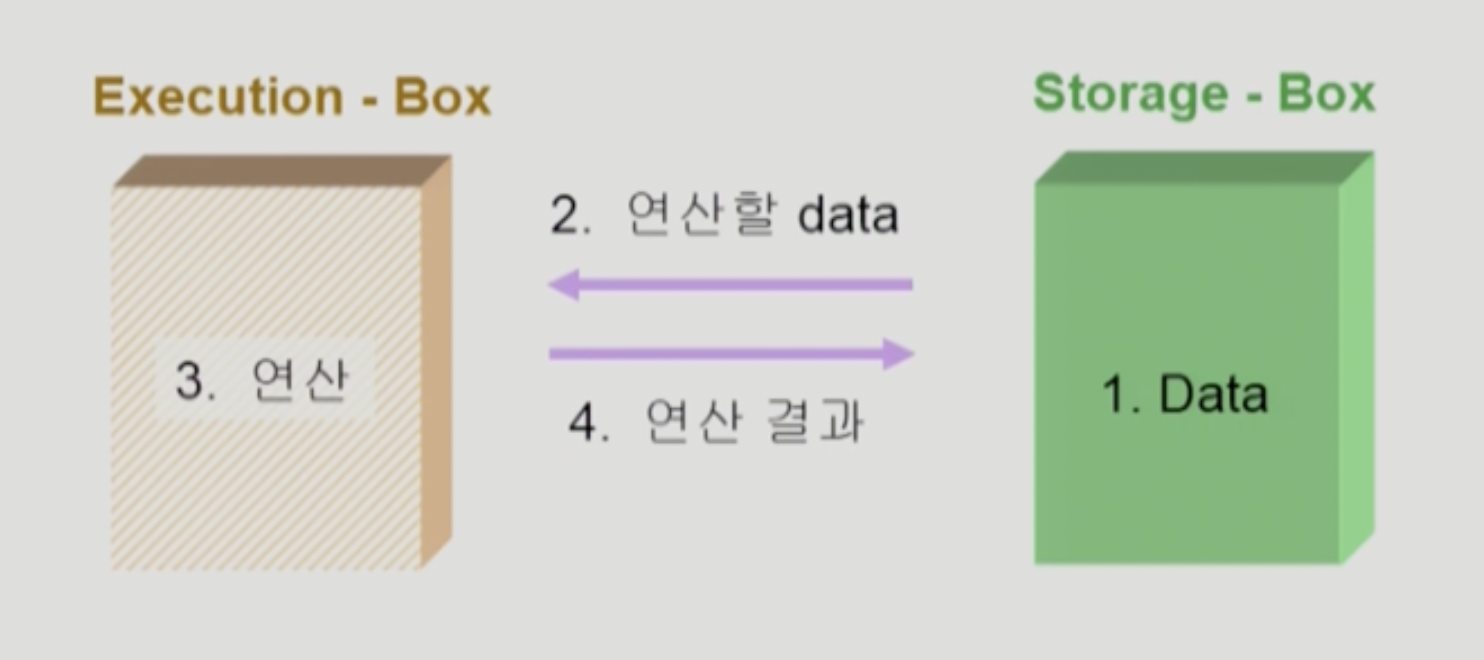
Example :
| E-box | S-box | |
|---|---|---|
| 1 | CPU | Memory |
| 2 | 컴퓨터 내부 | 디스크 |
| 3 | 프로세스 | 그 프로세스의 주소 공간 |
2. Race Condition
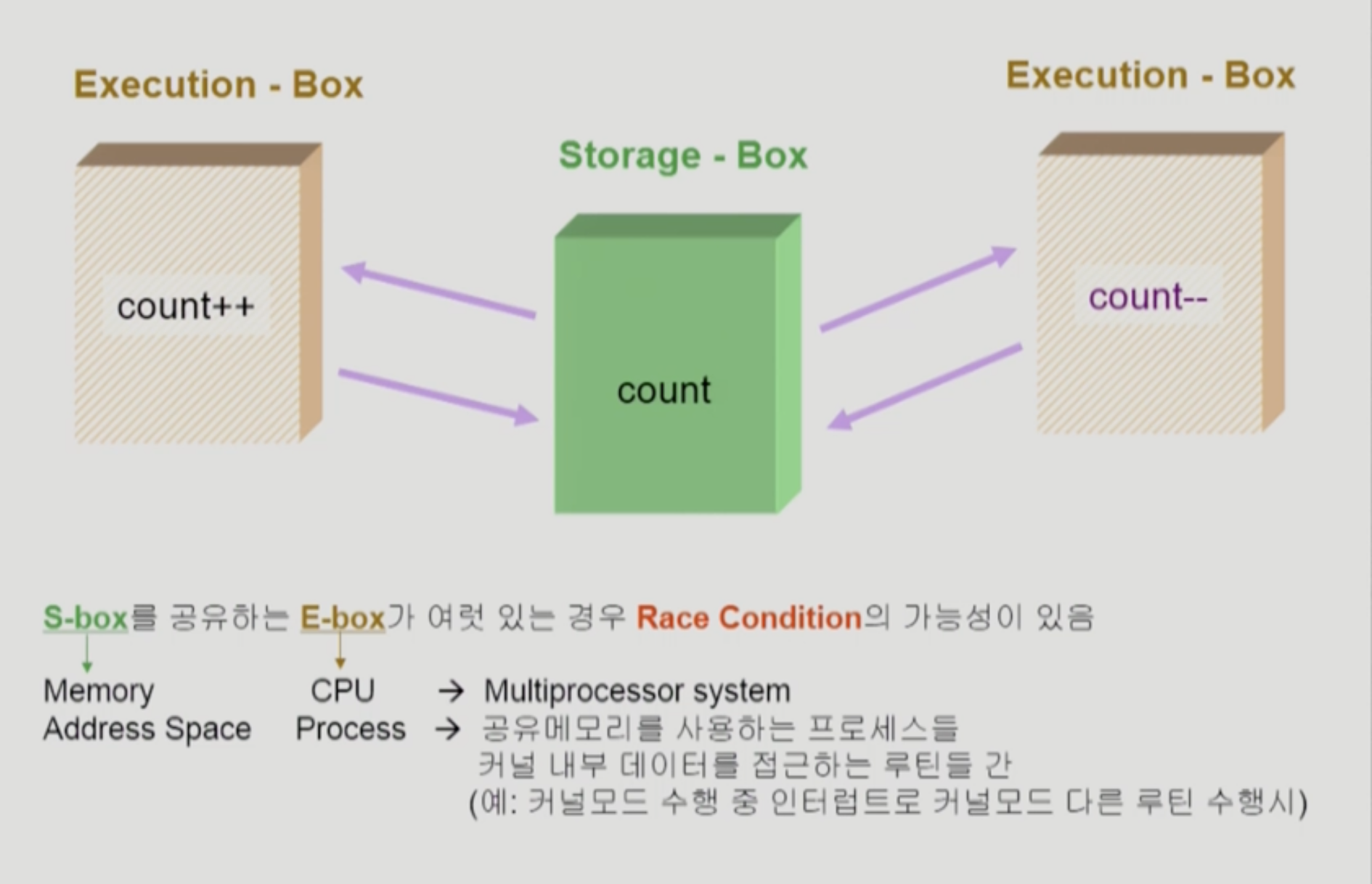
OS에서 race condition은 언제 발생하는가?
- kernel 수행 중 인터럽트 발생 시
- Process가 system call을 하여 kernel mode로 수행 중인데 context switch가 일어나는 경우
- Multiprocessor에서 shared memory 내의 kernel data
2-1. OS에서의 race condition 1
interrupt handler vs kernel
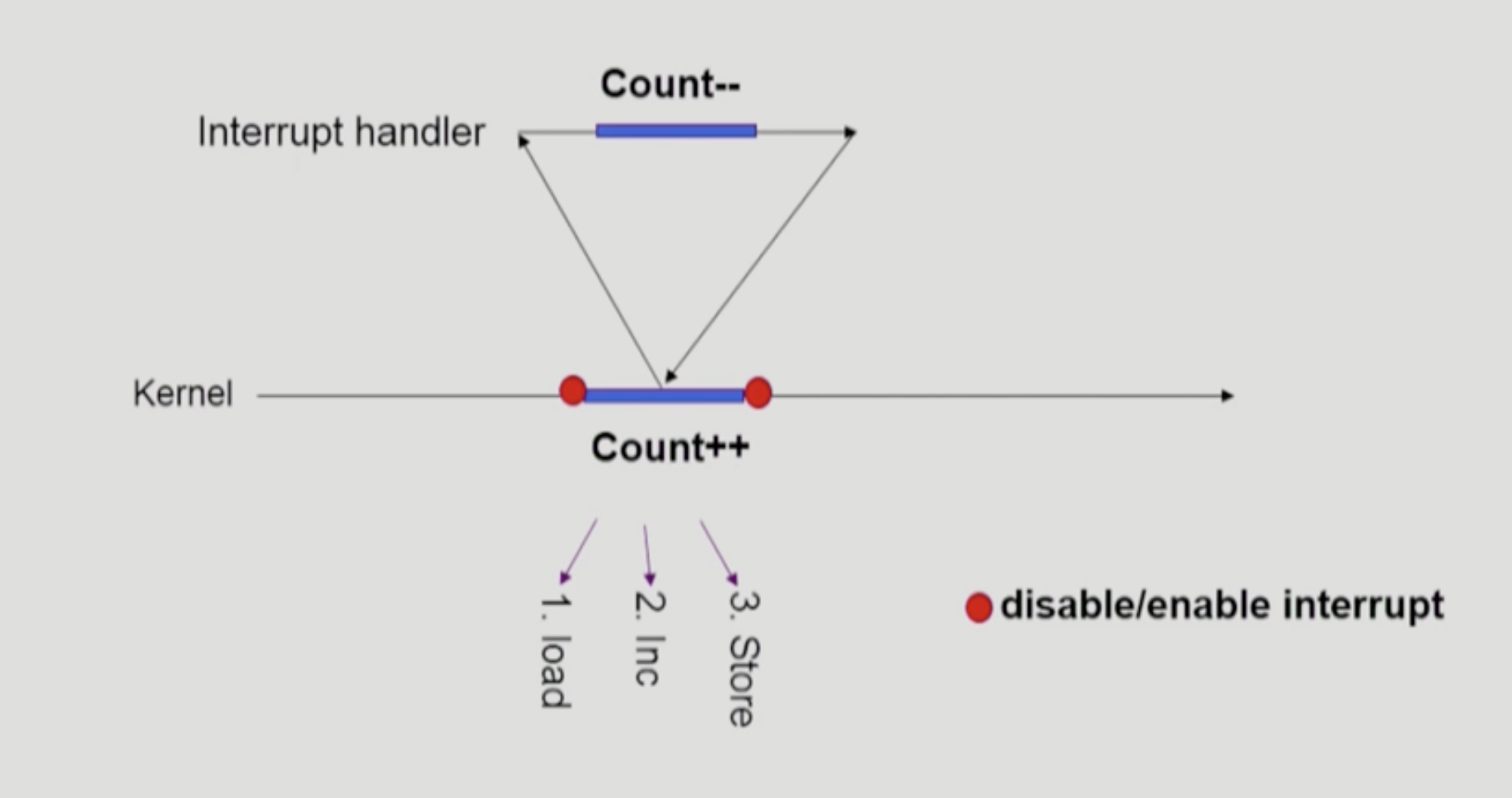
- 커널모드 running 중 interrupt가 발생하여 인터럽트 처리루틴이 수행
- 양쪽 다 커널 모드이므로 kernel address space 공유
2-2. OS에서의 race condition 2
Preempt a process running in kernel?
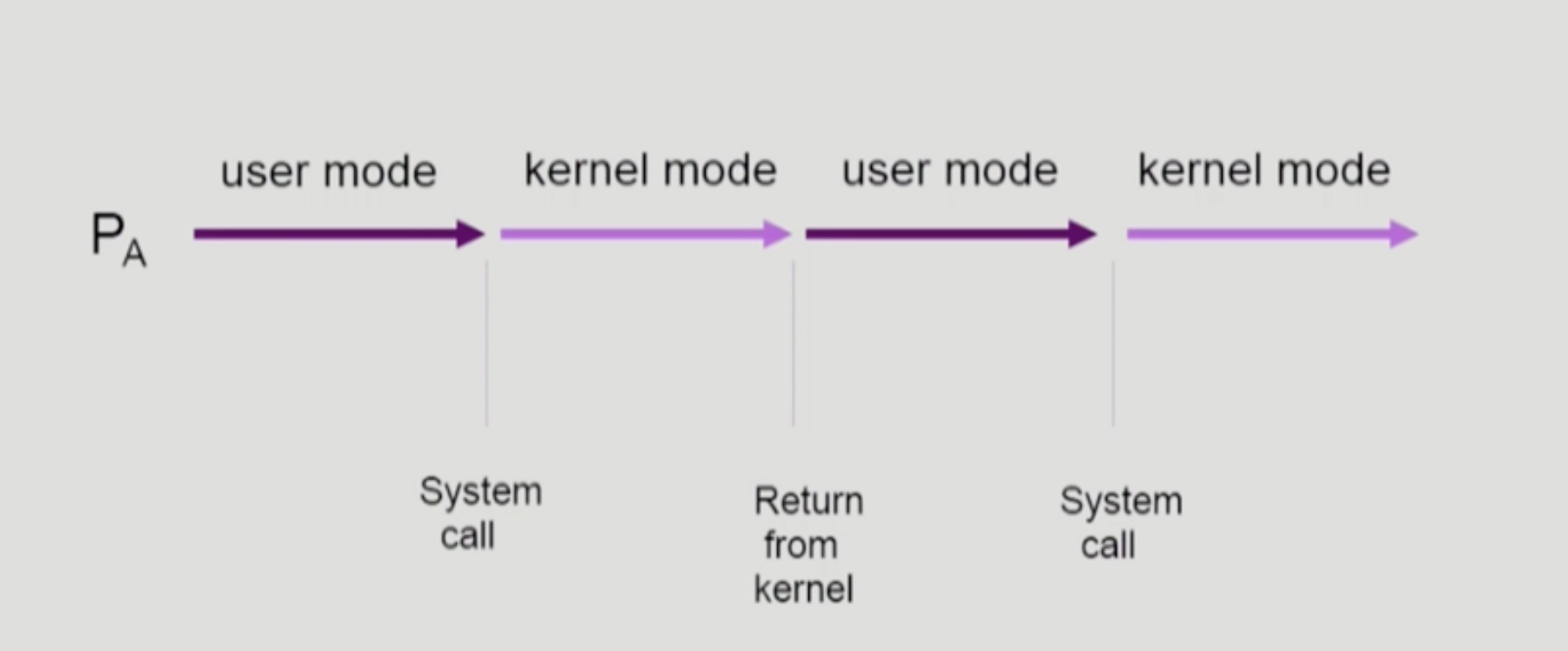
-
두 프로세스의 address space 간에는 data sharing이 없음
-
그러나 system call을 하는 동안에는 kernel address space의 data를 access하게 됨 (share)
-
이 작업 중간에 CPU를 preempt 해가면 race condition 발생
If you preempt CPU while in kernel mode ...
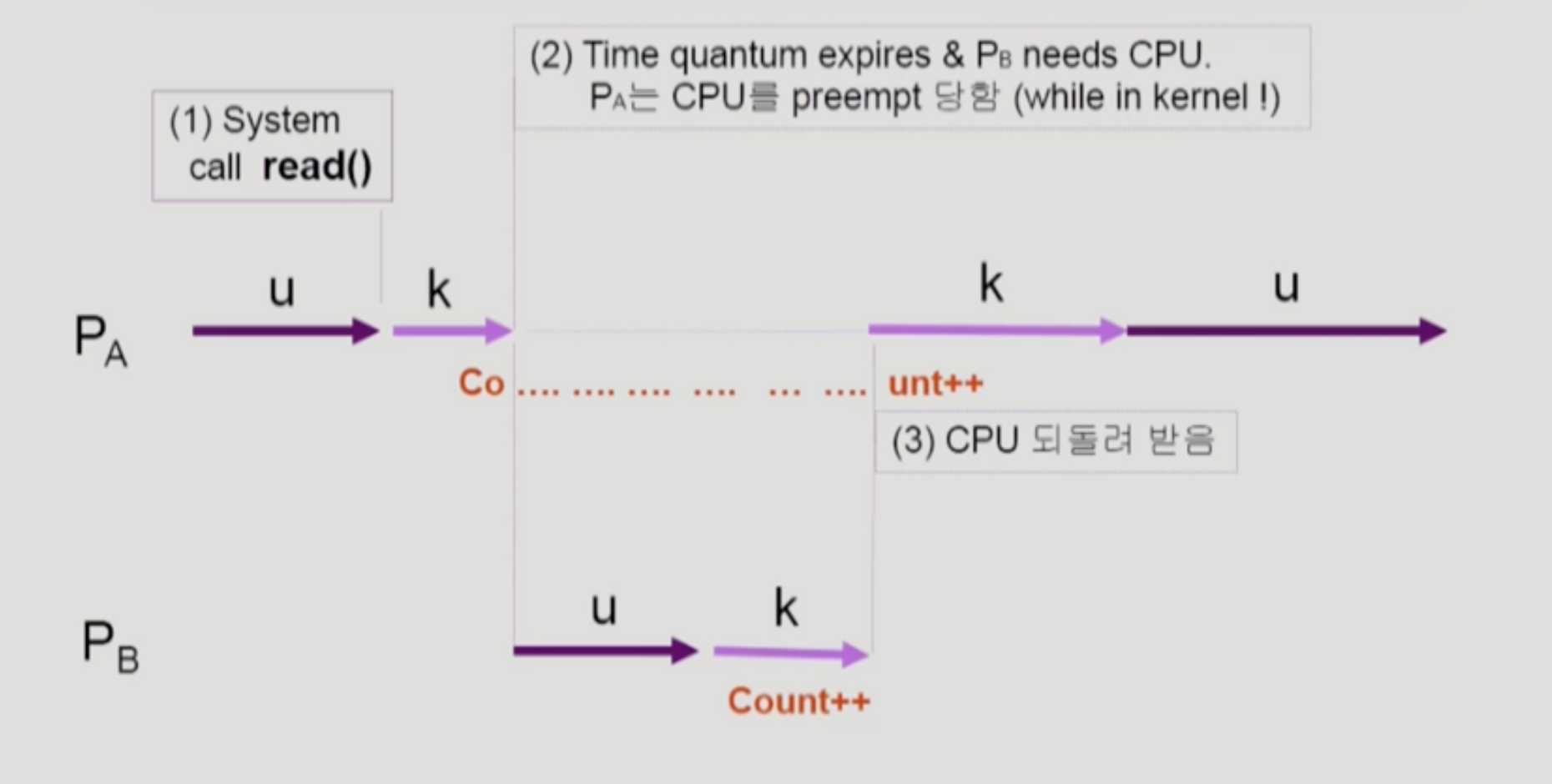
해결책
-
커널 모드에서 수행 중일 때는 CPU를 preempt하지 않음
-
커널 모드에서 사용자 모드로 돌아갈 때 preempt
2-3. OS에서의 race condition 3
multiprocessor

어떤 CPU가 마지막으로 count를 store했는가? ➔ race condition
multiprocessor의 경우 interrupt enable/disable로 해결되지 않음
방법 1
- 한번에 하나의 CPU만이 커널에 들어갈 수 있게 하는 방법
방법 2
- 커널 내부에 있는 각 공유 데이터에 접근할 때마다 그 데이터에 대한 lock / unlock을 하는 방법
3. Process Synchronization 문제
-
공유 데이터(shared data)의 동시 접근(concurrent access)은 데이터의 불일치 문제(inconsistency)를 발생시킬 수 있다.
-
일관성(consistency) 유지를 위해서는 협력 프로세스(cooperating process) 간의 실행 순서(orderly execution)를 정해주는 메커니즘 필요
-
Race condition
- 여러 프로세서들이 동시에 공유 데이터를 접근하는 상황
- 데이터의 최종 연산 결과는 마지막에 그 데이터를 다룬 프로세스에 따라 달라짐
-
race condition을 막기 위해서는 concurrent process는 동기화(synchronize)되어야 한다.
Example of a Race Condition
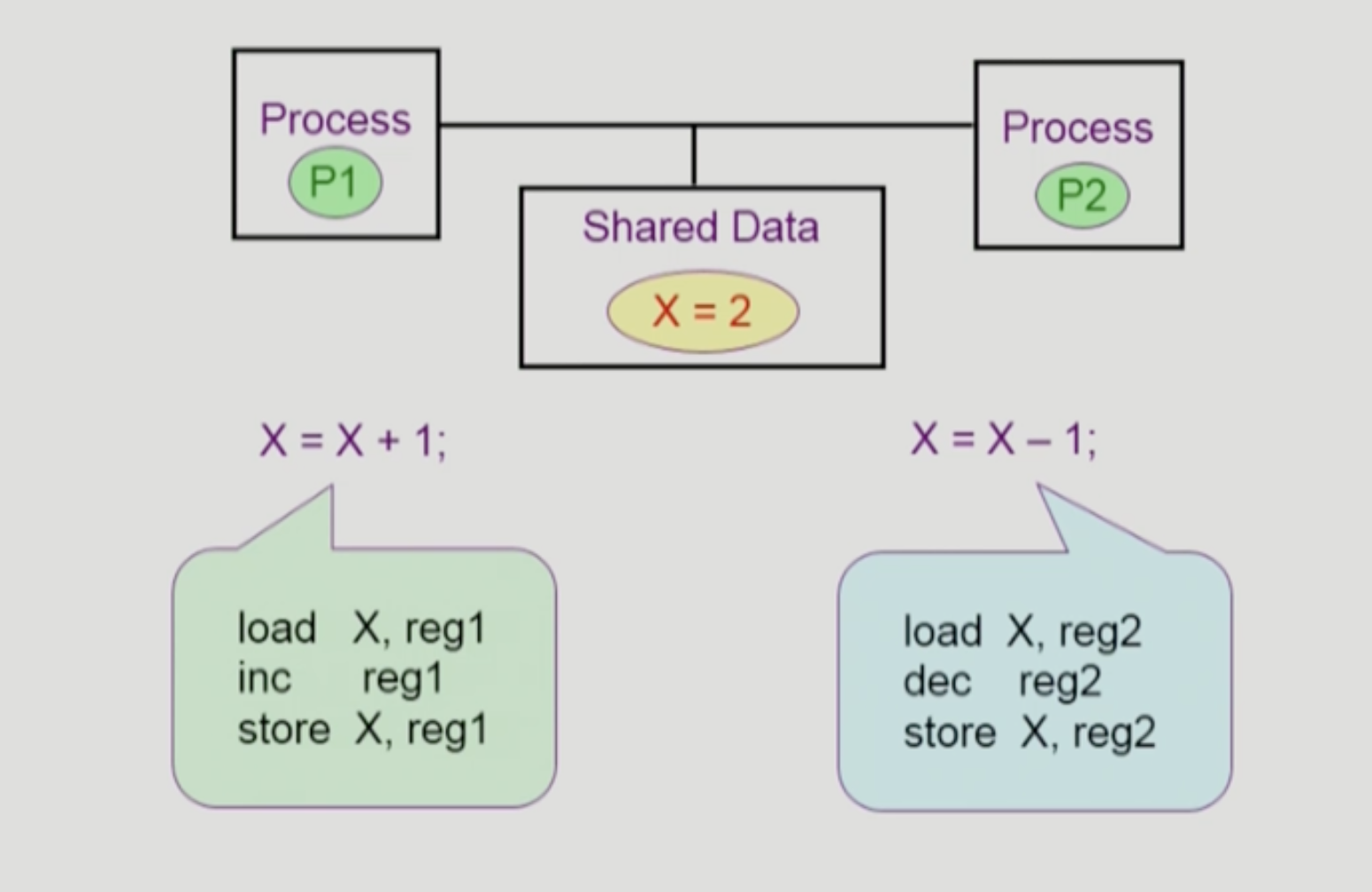
사용자 프로세스 P1 수행중 timer interrupt가 발생해서 context switch가 일어나서 P2가 CPU를 잡으면? ➔ 보통은 문제가 안생김
4. The Critical-Section(임계 구역) Problem
-
n 개의 프로세스가 공유 데이터를 동시에 사용하기를 원하는 경우
-
각 프로세스의 code segment에는 공유 데이터를 접근하는 코드인 critical section이 존재
-
Problem
- 하나의 프로세스가 critical section에 있을 때 다른 모든 프로세스는 critical section에 들어갈 수 없어야 한다.
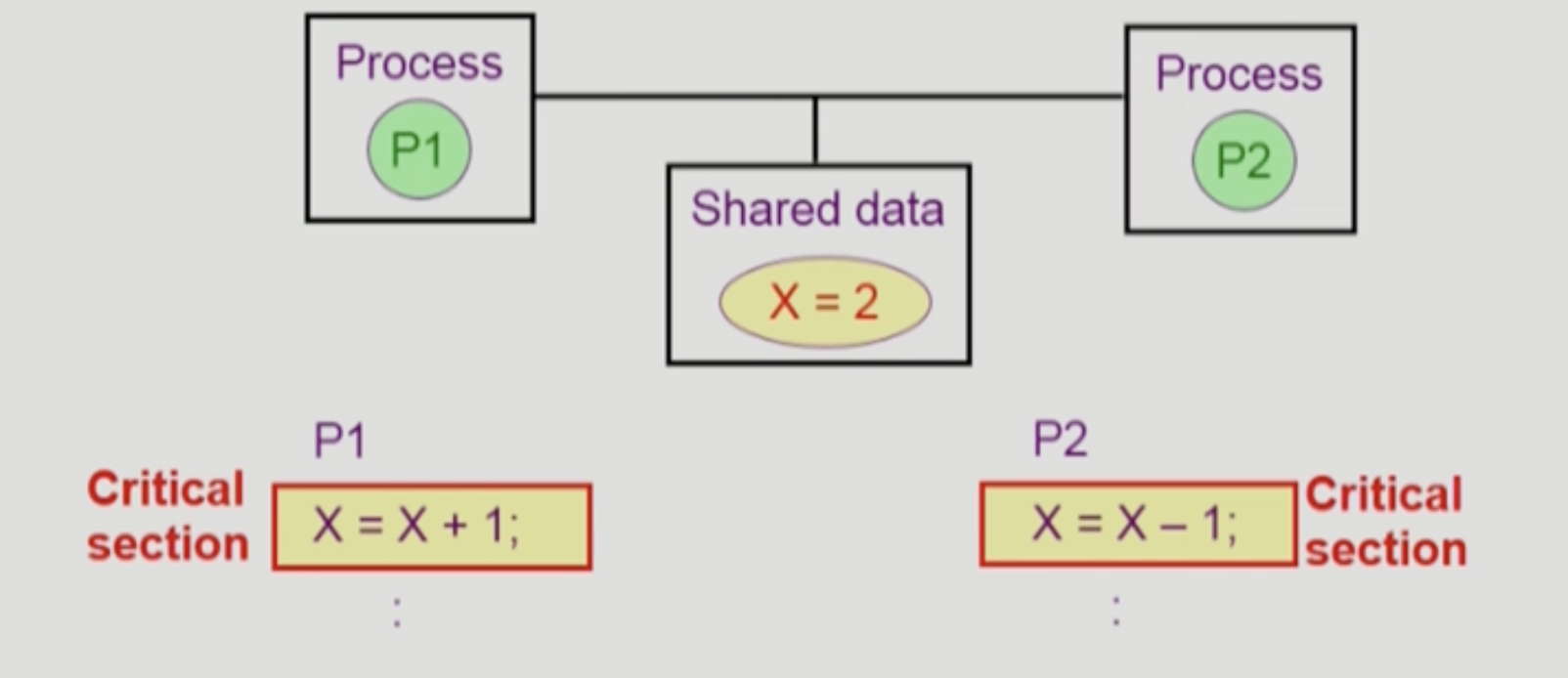
5. Initial Attempts to Solve Problem
-
두 개의 프로세스가 있다고 가정 : P0, P1
-
프로세스들의 일반적인 구조
do {
entry section
critical section
exit section
remainer section
} while (1);- 프로세스들은 수행의 동기화(synchronize)를 위해 몇몇 변수를 공유할 수 있다 ➔
synchronization variable
5-1. 프로그램적 해결법의 충족 요건
-
Mutal Exclusion (상호 배제)
- 프로세스 Pi가 critical section 부분을 수행 중이면 다른 모든 프로세스들은 그들의 critical section에 들어가면 안 된다.
-
Progress (진행)
- 아무도 critical section에 있지 않은 상태에서 critical section에 들어가고자 하는 프로세스가 있으면 critical section에 들어가게 해주어야 한다.
-
Bounded Waiting (유한 대기)
- 프로세스가 critical section에 들어가려고 요청한 후부터 그 요청이 허용될 때까지 다른 프로세스들이 critical section에 들어가는 횟수에 한계가 있어야 한다.
-
가정
- 모든 프로세스의 수행 속도는 0보다 크다.
- 프로세스들 간의 상대적인 수행 속도는 가정하지 않는다.
5-2. Algorithm 1
Synchronization variable :
int turn;
initially turn = 0; // Pi can enter its critical section if (turn == i)Process P0 :
do {
while (turn != 0); // My turn?
critical section
turn = 1;
remainder section // Now it's your turn
} while (1);-
Satisfies mutual exclusion(상호 배제), but not progress(진행)
-
즉, 과잉양보 :
- 반드시 한번씩 교대로 들어가야만 함 (swap-turn)
- 그가 turn을 내 값으로 바꿔줘야만 내가 들어갈 수 있음
- 특정 프로세스가 더 빈번히 critical section을 들어가야 한다면?
5-3. Algorithm 2
Synchronization variable :
boolean flag[2];
initially flag[모두] = false; // no one is in CSPi ready to enter its critical section if (flag[i] == true)Process Pi :
do {
flag[i] = true; // Pretend I am in
while (flag[j]); // Is he also in? then wait
critical section
flag[i] = false; // I am out now
remainder section
} while (1);-
Satisfies mutual exclusion(상호 배제), but not progress requirement(진행)
-
둘 다 2행까지 수행 후 끊임 없이 양보하는 상황 발생 가능
5-4. Algorithm 3 (Peterson's Algorithm)
Combined synchronization variables of algorithm 1 and 2
Process Pi :
do {
flag[i] = true; // My intention is to enter...
turn = j; // Set to his turn
while (flag[j] && turn ==j); // wait only if...
critical section
flag[i] = false;
remainder section
} while(1);-
Meets all three requirements; solves the critical section problem for two processes
-
Busy Waiting(= spin lock)! (계속 CPU와 memory를 쓰면서 wait)
5-5. Synchronization Hardware
하드웨어적으로 Test & modify를 atomic하게 수행할 수 있도록 지원하는 경우 앞의 문제는 간단히 해결
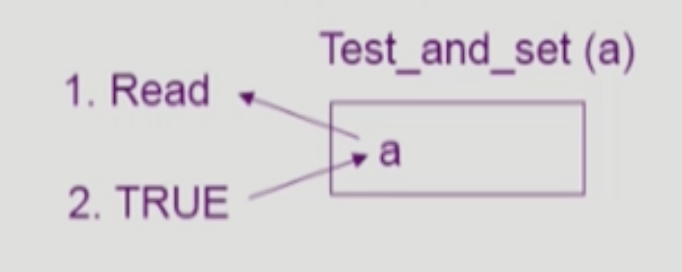
5-5-1. Mutual Exclusion with Test & Set
Synchronization variable :
boolean lock = false;Process Pi :
do {
while (Test_and_Set(lock));
critical section
lock = false;
remainder section
}
6. Semaphores
앞의 방식들을 추상화시킴
6-1. Semaphore S
-
integer variable
-
아래의 두 가지 atomic 연산에 의해서만 접근 가능
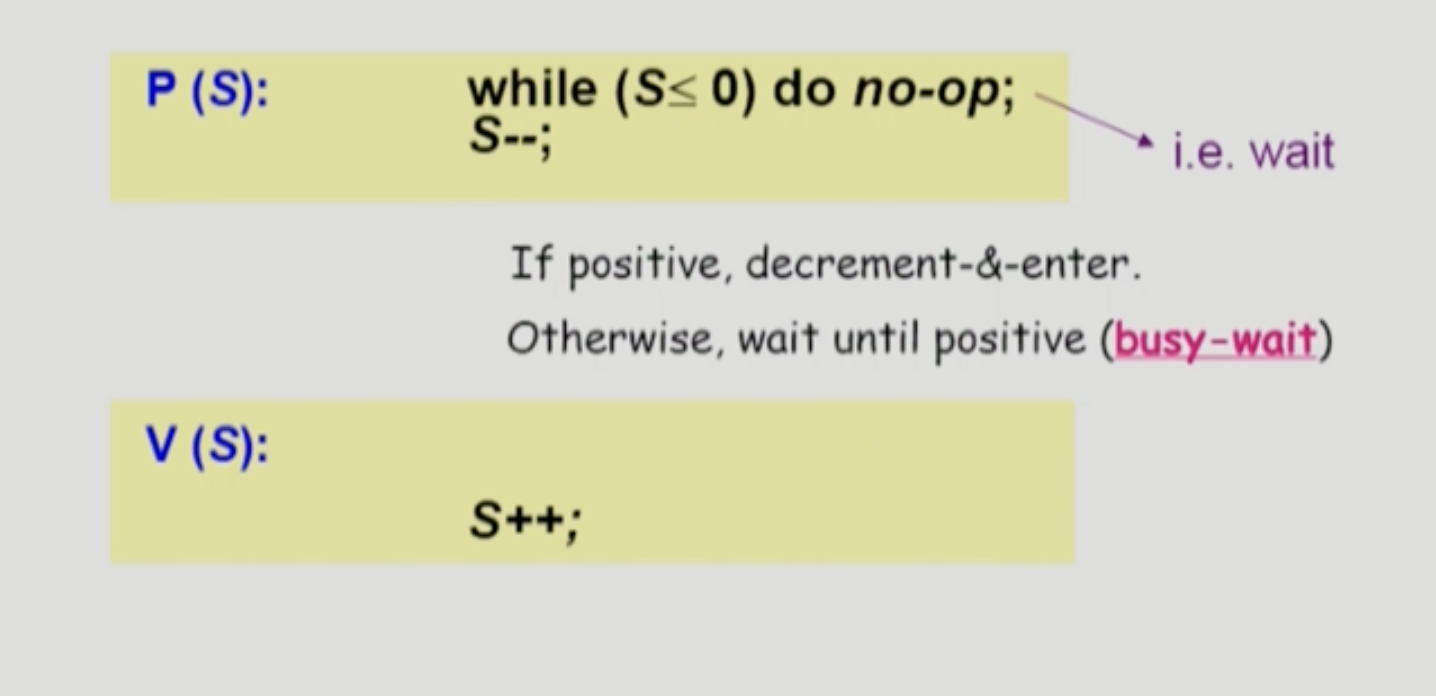
P 연산 : 공유 데이터를 획득하는 과정
V 연산 : 사용 후 반납하는 과정
S : 자원의 갯수
6-2. Critical Section of n Processes
Synchronization variable :
semaphore mutex; // initially 1 : 1개가 CS에 들어갈 수 있다Process Pi :
do {
P(mutex); // If positive, dec-&-enter, otherwise wait
critical section
V(mutex); // Increment semaphore
remainder section
} while (1);-
busy-wait는 효율적이지 못함 (= spin lock) (위 방식)
-
Block & Wakeup 방식의 구현 (= sleep lock) (아래 방식)
6-3. Block & Wakeup Implementation
Semaphore를 다음과 같이 정의 :
typedef struct
{
int value; // semaphore
struct process *L; // process wait queue
} semaphore;block과 wakeup을 다음과 같이 가정 :
-
block
- 커널은 block을 호출한 프로세스를 suspend시킴
- 이 프로세스의 PCB를 semaphore에 대한 wait queue에 넣음
-
wakeup(P)
- block된 프로세스 P를 wakeup시킴
- 이 프로세스의 PCB를 ready queue로 옮김

6-4. Block & Wakeup version of P() & V()
Semaphore 연산이 이제 다음과 같이 정의됨 :
P(S) :
S.value--; // prepare to enter
if (S.value < 0) // Oops, negative, I cannot enter
{
add this process to S.L;
block();
}V(S) :
S.value++;
if (S.value <= 0)
{
remove a process P form S.L;
wakeup(P);
}6-5. Which is better? (Busy-wait vs Block & Wakeup)
Block & Wakeup overhead vs Critical section 길이
-
Critical section의 길이가 긴 경우 Block & Wakeup이 적당
-
Critical section의 길이가 매우 짧은 경우 Block & Wakeup 오버헤드가 busy-wait 오버헤드보다 더 커질 수 있음
-
일반적으로는 Block & Wakeup 방식이 더 좋음
6-6. Two Types of Semaphores
-
Counting semaphore
- 도메인이 0 이상인 임의의 정수값
- 주로 resource counting에 사용
-
Binary semaphore (=mutex)
- 0 또는 1 값만 가질 수 있는 semaphore
- 주로 mutual exclusion (lock / unlock)에 사용
7. Deadlock and Starvation
- Deadlock
- 둘 이상의 프로세스가 서로 상대방에 의해 충족될 수 있는 event를 무한히 기다리는 현상
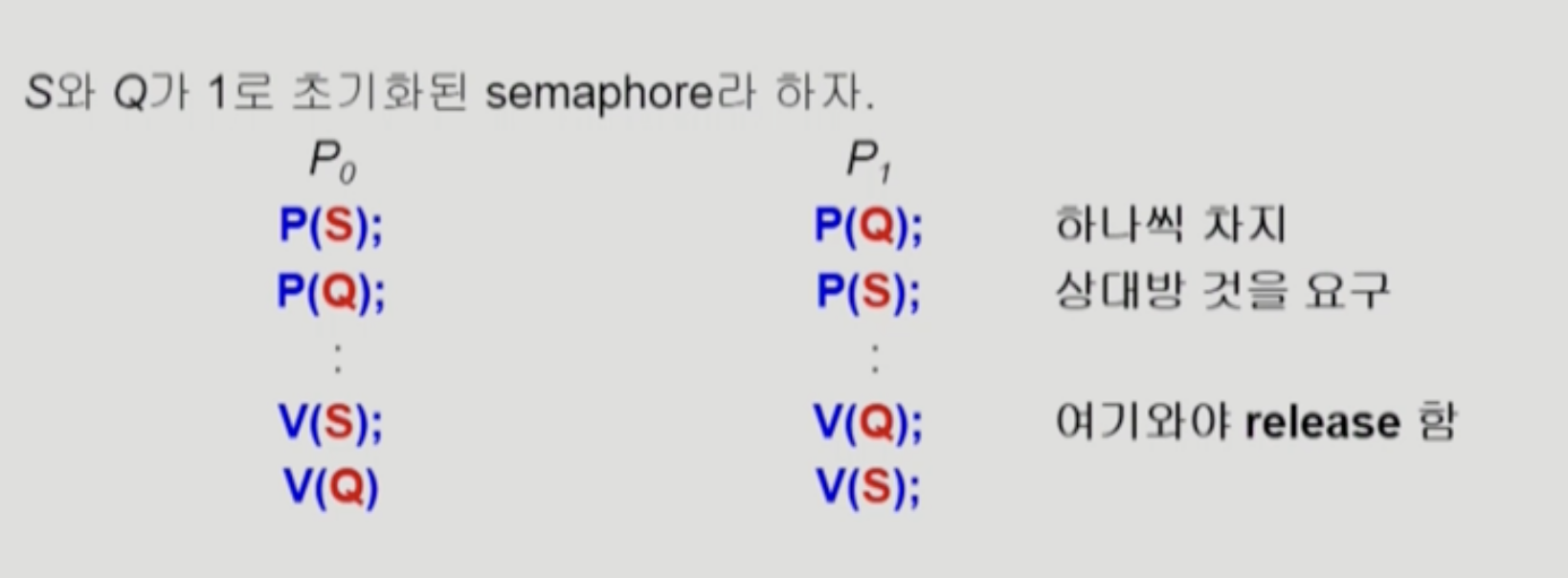
- Starvation
- indefinite blocking : 프로세스가 suspend된 이유에 해당하는 세마포어 큐에서 빠져나갈 수 없는 현상
8. Classical Problems of Synchronization
8-1. Bounded-Buffer Problem (Producer-Consumber Problem)
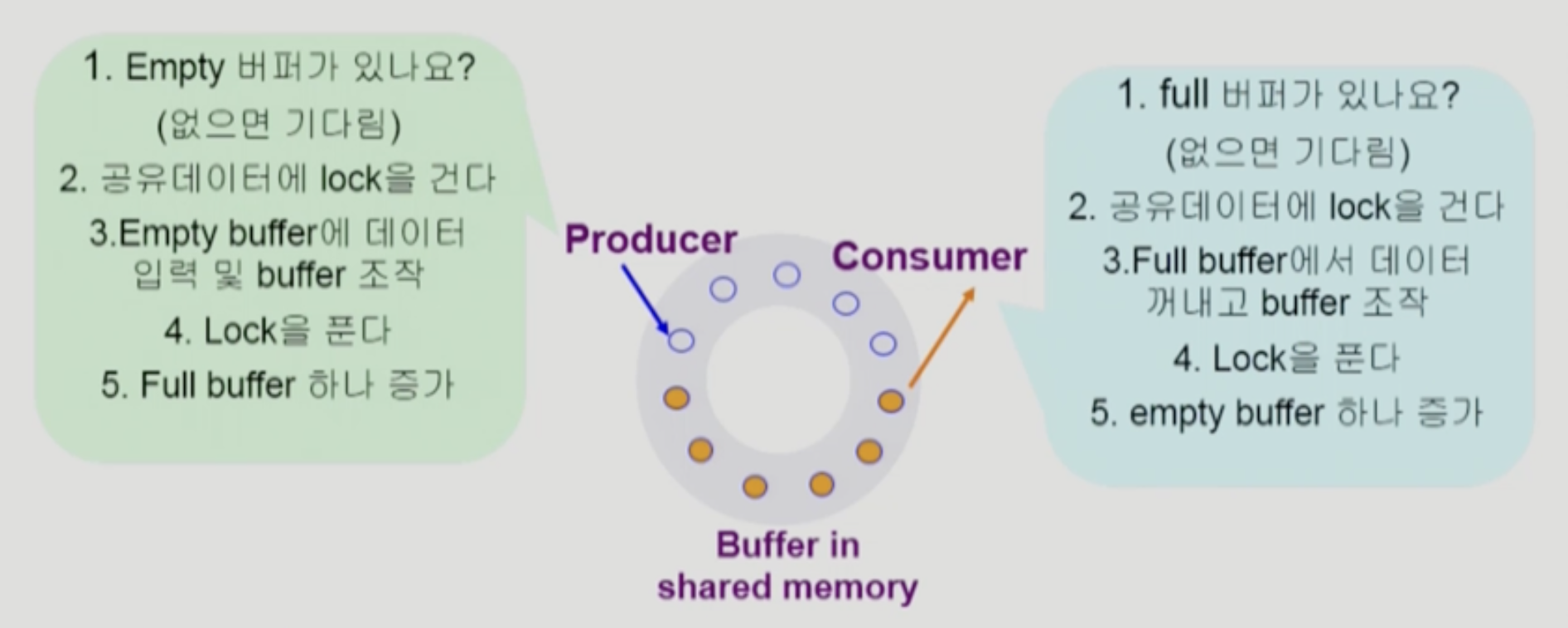
-
Shared data
- buffer 자체 및 buffer 조작 변수 (empty/full buffer의 시작 위치)
-
Synchronization variables
- mutual exclusion ➔ Need binary semaphore (shared data의 mutual exclusion을 위해)
- resource count ➔ Need integer semaphore (남은 full/empty buffer의 수 표시)
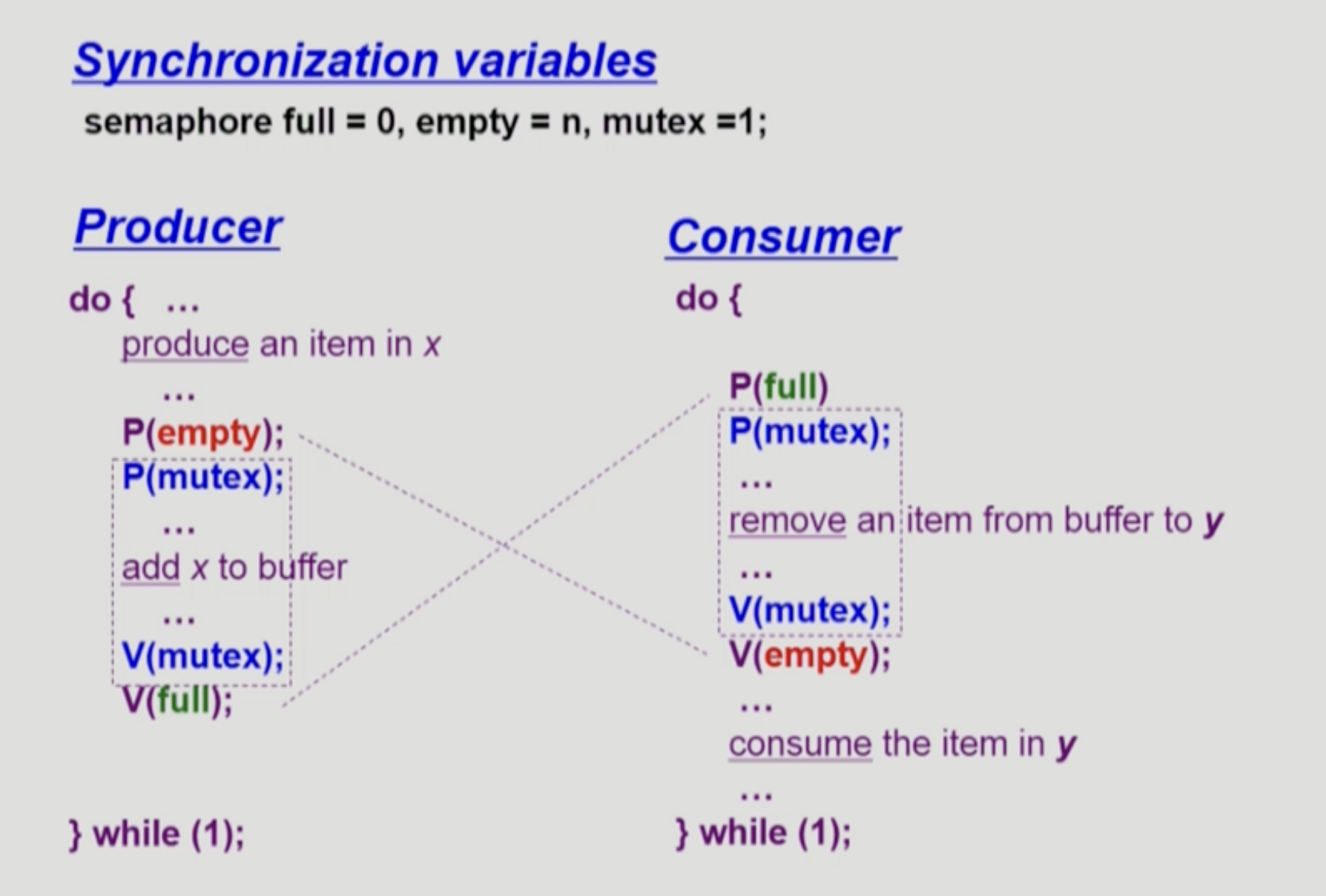
8-2. Readers and Writers Problem
-
한 process가 DB에 write 중일 때 다른 process가 접근하면 안됨
-
read는 동시에 여럿이 해도 됨
-
solution
- Writer가 DB에 접근 허가를 아직 얻지 못한 상태에서는 모든 대기중인 Reader들을 다 DB에 접근하게 해준다.
- Writer는 대기 중인 Reader가 하나도 없을 때 DB 접근이 허용된다.
- 일단 Writer가 DB에 접근 중이면 Reader들은 접근이 금지된다.
- Writer가 DB에서 빠져나가야만 Reader의 접근이 허용된다.
-
Shared data
- DB 자체
- readcount ➔ 현재 DB에 접근 중인 Reader의 수
-
Synchronization variables
- mutax ➔ 공유 변수 readcount를 접근하는 코드(critical section)의 mutual exclusion 보장을 위해 사용
- db ➔ Reader와 Writer가 공유 DB 자체를 올바르게 접근하게 하는 역할
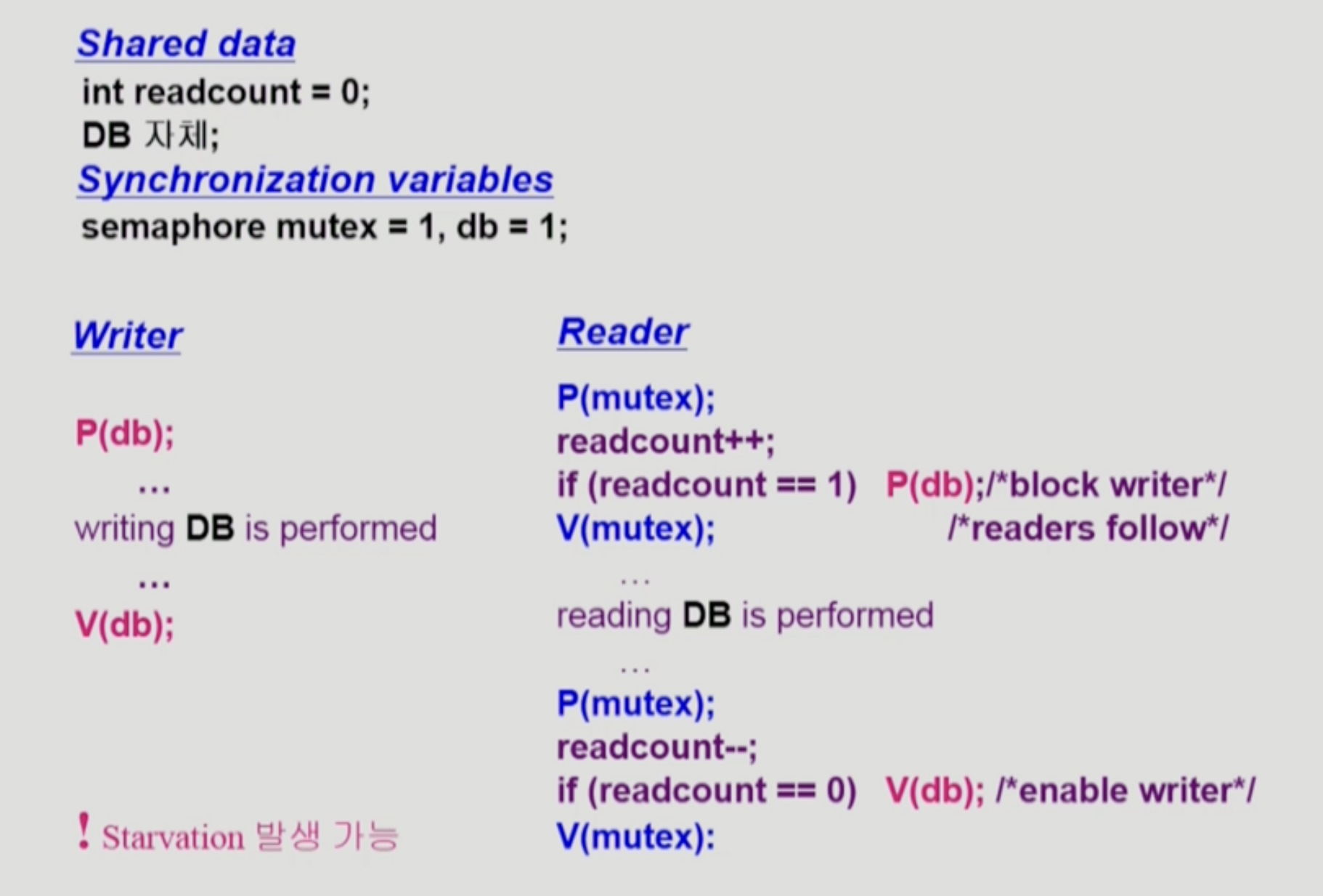
8-3. Dining-Philosophers Problem
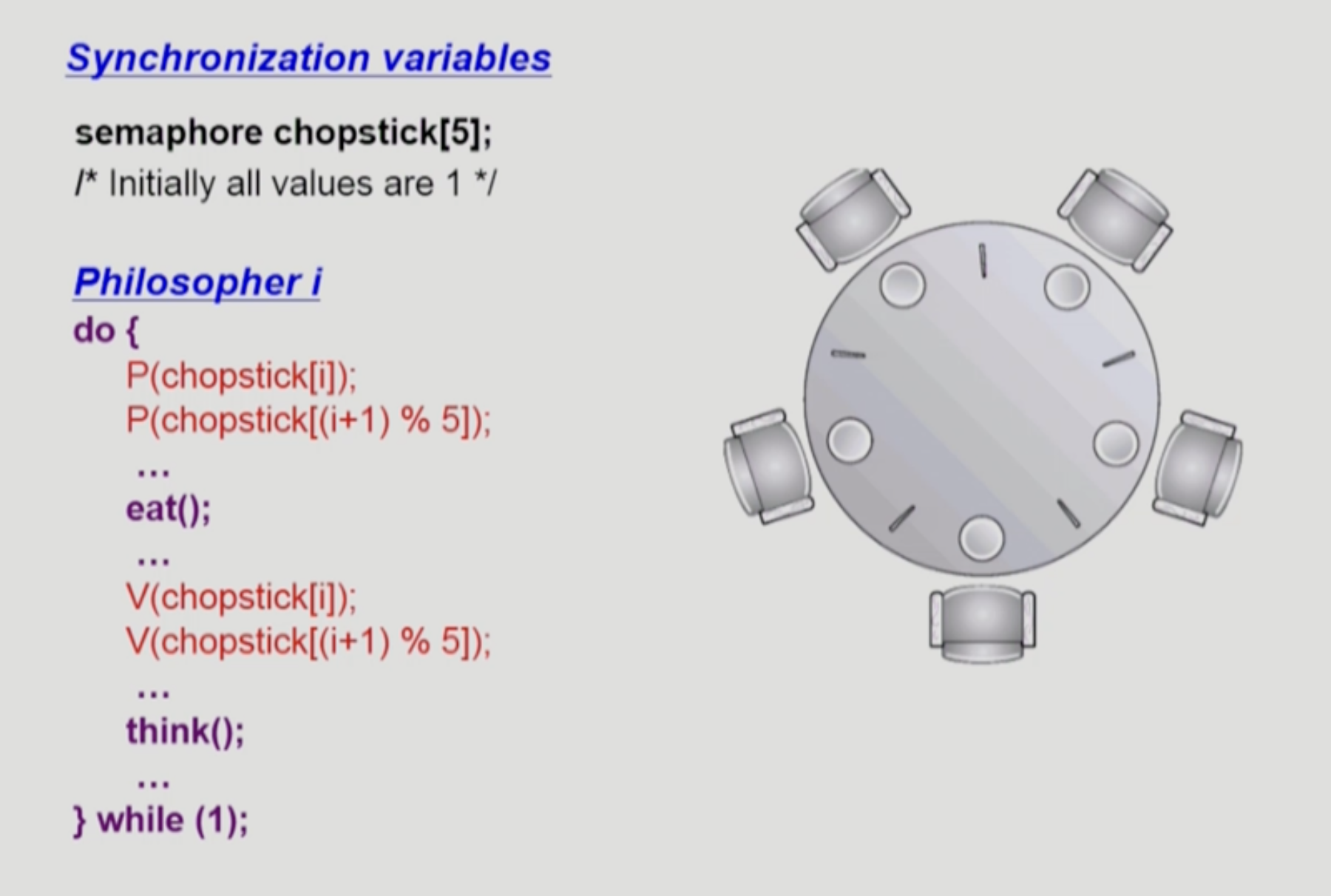
위 그림 solution의 문제점
-
Deadlock 가능성이 있다.
-
모든 철학자가 동시에 배가 고파져 왼쪽 젓가락을 집어버린 경우
해결 방안
-
4명의 철학자만이 테이블에 동시에 앉을 수 있도록 한다.
-
젓가락을 두 개 모두 집을 수 있을 때에만 젓가락을 집을 수 있게 한다. (아래 그림)
-
비대칭 : 짝수(홀수) 철학자는 왼쪽(오른쪽) 젓가락부터 집도록 한다.
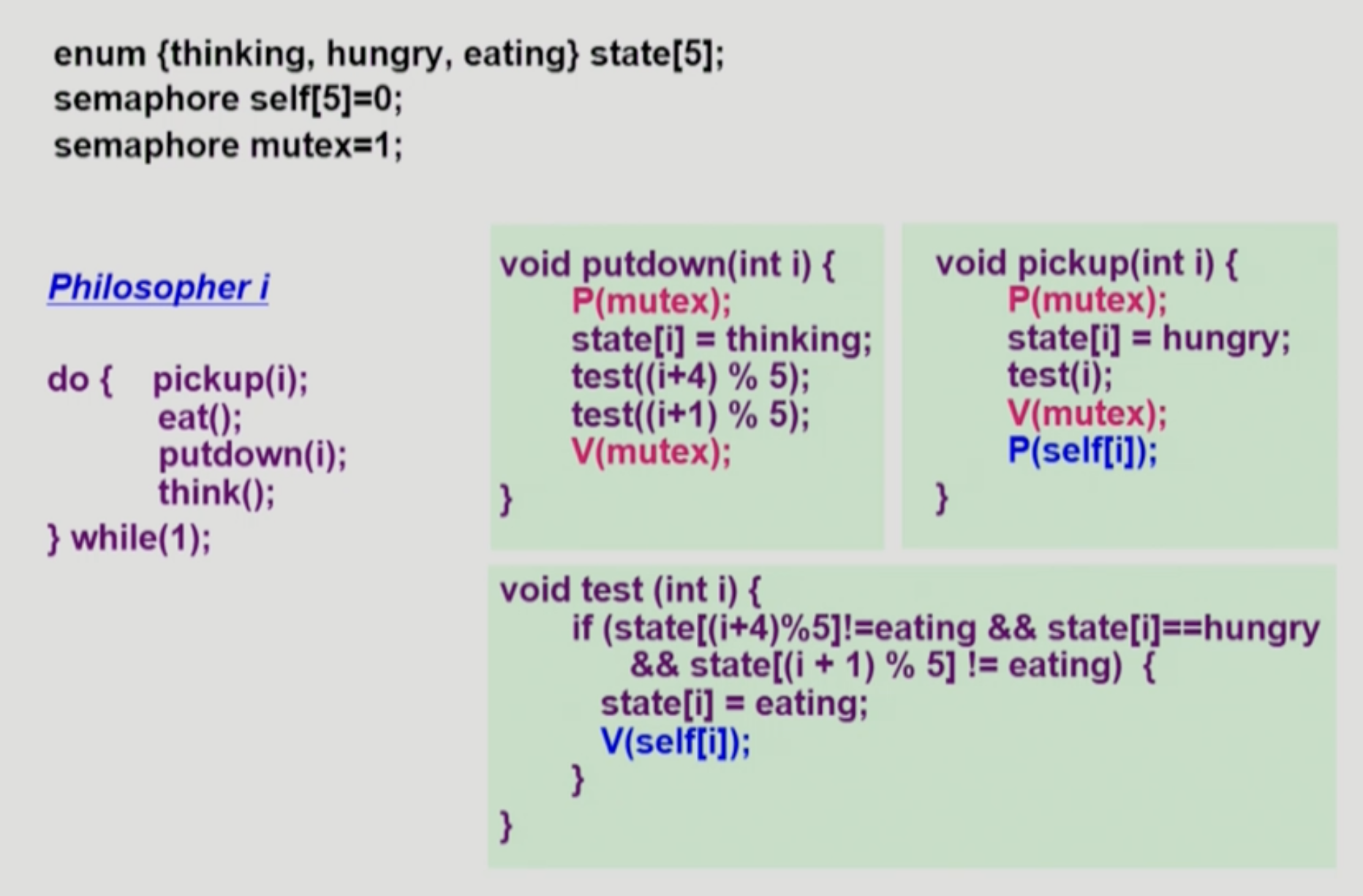
9. Monitor
Semaphore의 문제점
-
코딩하기 힘들다.
-
정확성(correctness)의 입증이 어렵다.
-
자발적 협력(voluntary cooperation)이 필요하다.
-
한번의 실수가 모든 시스템에 치명적 영항을 미친다.
Example :

Monitor : 동시 수행중인 프로세스 사이에서 abstract data type의 안전한 공유를 보장하기 위한 high-level synchronization construct (Semaphore와 다르게 lock을 할 필요 X)
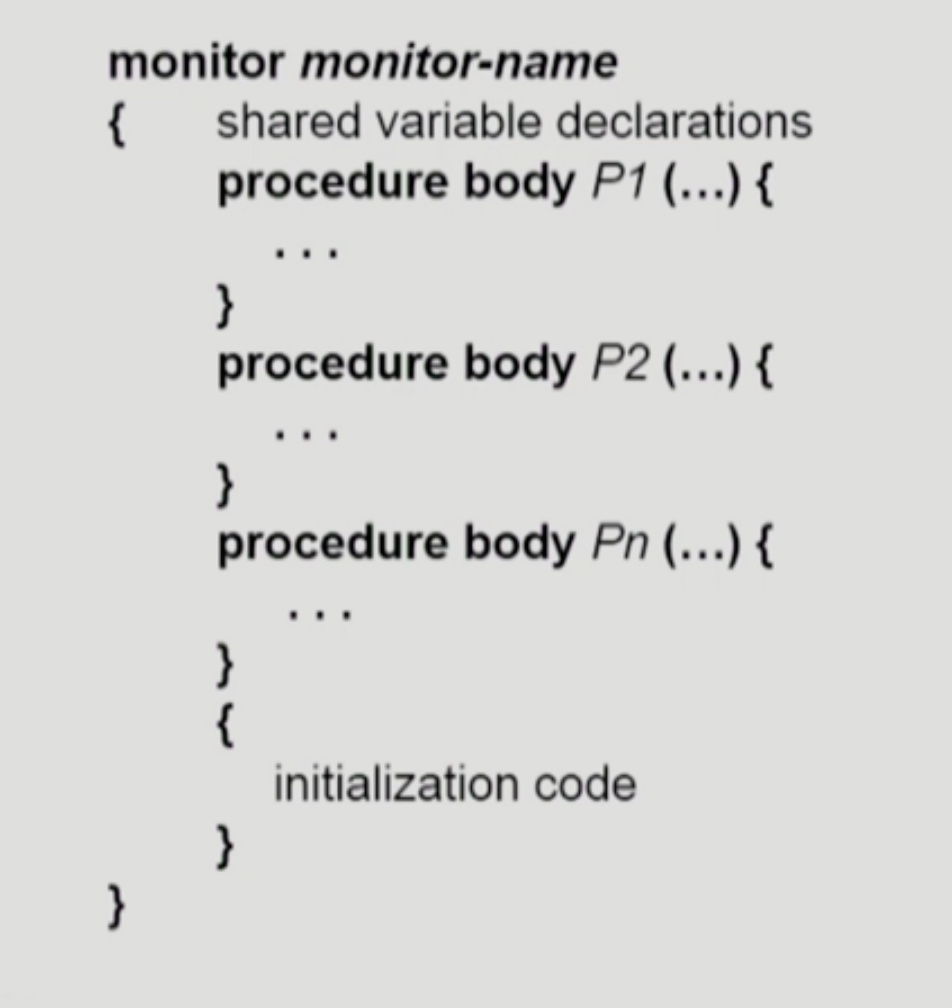
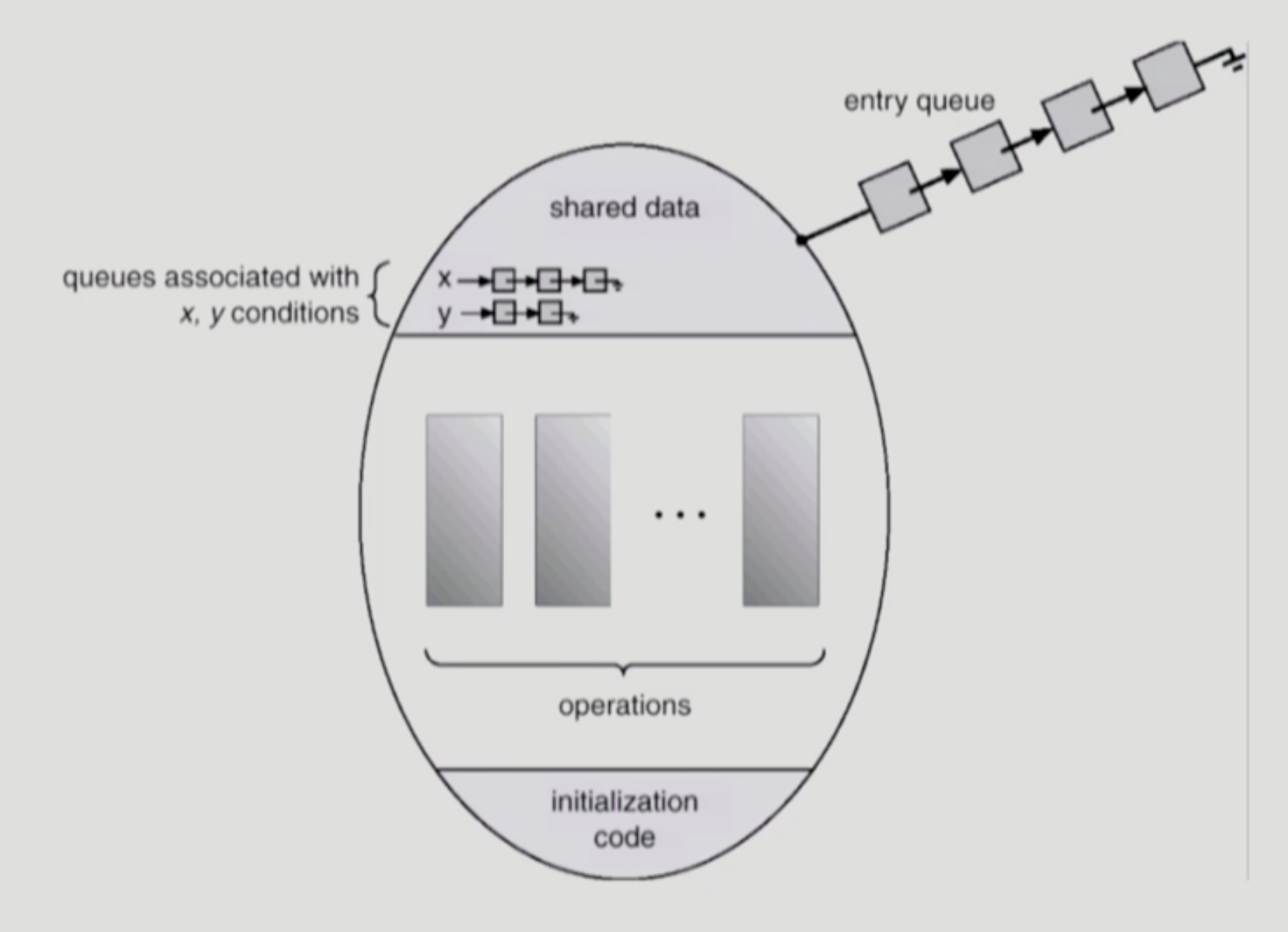
-
모니터 내에서는 한번에 하나의 프로세스만이 활동 가능
-
프로그래머가 동기화 제약 조건을 명시적으로 코딩할 필요없음
-
프로세스가 모니터 안에서 기다릴 수 있도록 하기 위해
condition variable사용
condition x, y;condition variable은wait와signal연산에 의해서만 접근 가능
x.wait();
x.signal();-
x.wait()을 invoke한 프로세스는 다른 프로세스가x.signal()을 invoke하기 전까지 suspend된다. -
x.signal()은 정확하게 하나의 suspend된 프로세스를 resume한다. -
suspend된 프로세스가 없으면 아무 일도 일어나지 않는다.
9-1. Bounded-Buffer Problem
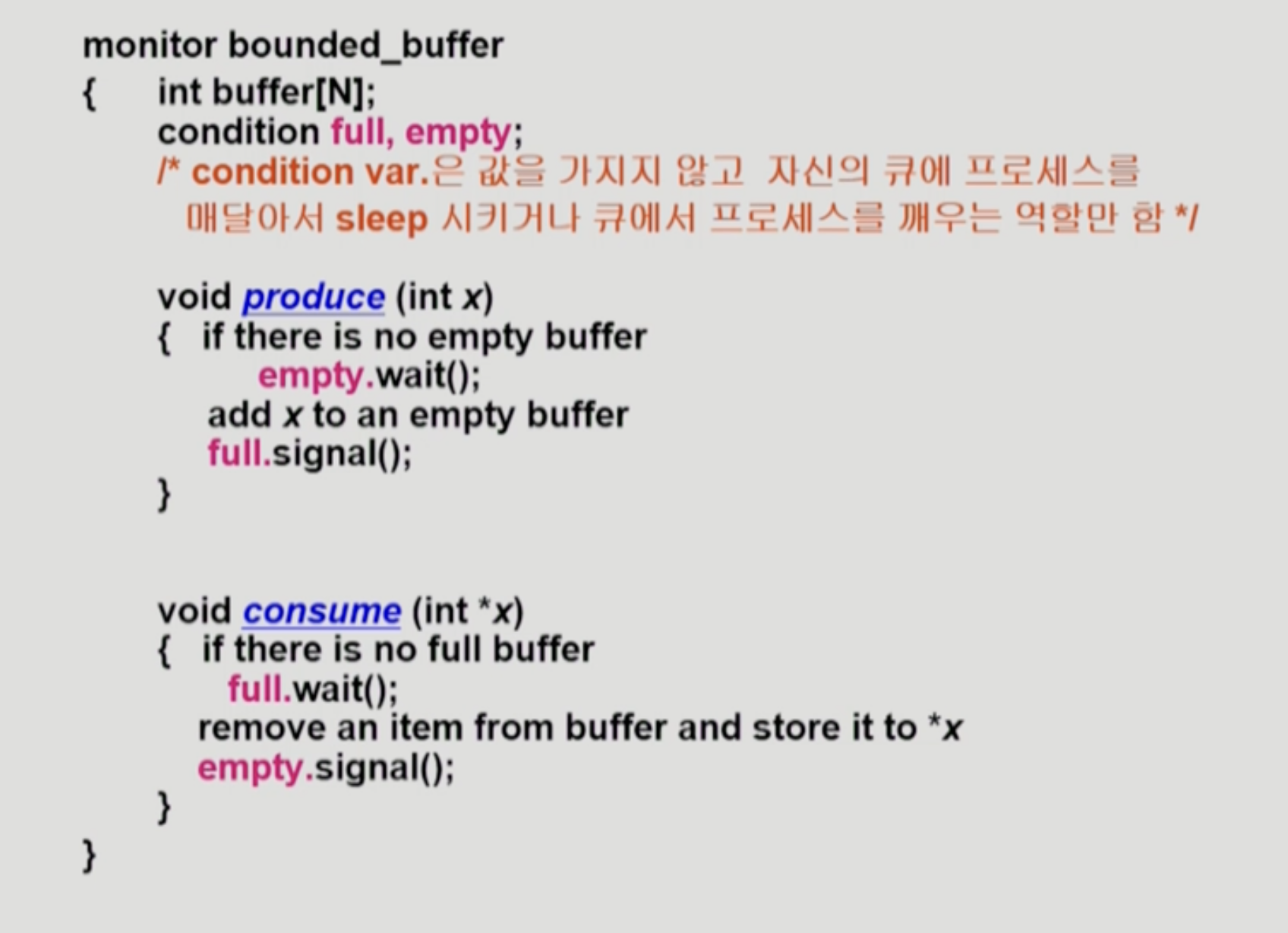
9-2. Dining-Philosophers Problem


